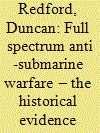| Srl | Item |
| 1 |
ID:
143071


|
|
|
| 2 |
ID:
183166


|
|
|
|
|
| Summary/Abstract |
Submarines are pressing their way back to the top of the maritime agenda. To deal with the burgeoning submarine threat, the full spectrum approach to anti-submarine warfare has been developed. Its ten threads hope to defeat – as opposed to destroy – hostile submarines. This paper will explore the historical evidence surrounding the full spectrum approach. It will argue that the historical evidence for many of the threads is weak, but that when the fundamentals of submarine warfare are considered many of the lessons of WW1 and WW2 may still be relevant to today’s practitioners.
|
|
|
|
|
|
|
|
|
|
|
|
|
|
|
|
| 3 |
ID:
143072


|
|
|
| 4 |
ID:
146950


|
|
|
| 5 |
ID:
143131


|
|
|
|
|
| Summary/Abstract |
The final two weeks of September 1918 were crucial for the modern history of Damascus. They marked exodus of the Ottoman Turks and entry of the Allied Forces, yet they have received mediocre attention from World War I historians. Most literature on the Great War in the Middle East covers British strategies in the Arab Revolt and Hashemite ambitions, revolving around the characters of T. E. Lawrence and Sharif Faisal. Most cover the years 1916–18, or the British-backed Arab government that was established on October 1, 1918, the day Lawrence entered Damascus. Never has scholarly attention been given as to what happened inside the city itself during these two weeks that preceded October 1, or to the community leaders who teamed up to protect Damascus from uncontrollable chaos that threatened to tear the city apart. This article looks at the two weeks inside the city, namely through one protagonist, being the self-appointed governor of Damascus, Emir Said El Djazairi.
|
|
|
|
|
|
|
|
|
|
|
|
|
|
|
|
| 6 |
ID:
146962


|
|
|